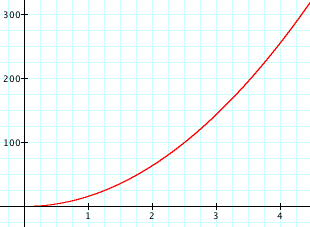
We defined average speed as The constant speed at which another object would need to travel in order to travel the same distance in the same amount of time as the object in question.
We calculate aveage speed by evaluating a ratio between changes in the distance an object has traveled as measured from some reference point and the time it took to travel that change in distance. When we evaluate this ratio, we get a rate of change. But as mentioned in the discussion of linear functions, the ideas of constant rate of change, linear function, and proportionality are inextricably intertwined.
We can generalize the idea of average speed to the idea of an average speed function. This function would track the distance traveled by the fictitious object that travels at a constant speed. We want it to begin at the same location as the actual object, ends at the same location as the actual object, and takes the same amount of time as the actual object takes to go from beginning to end.
Suppose that the function d, defined as d(t) = 16t2, gives the number of feet that an object has fallen from a resting start t seconds after it began to fall. Here is the graph of d for 0<t<4.5.

Here are two points on the graph y = d(x). (Note: In class we discussed how to help students not to be confused by a change in letter.) We discussed what these two points represent: That the first point's coordinates tell us that the object had fallen 96.285 feet after having fallen for 2.4531 seconds. The second point's coordinates tell us that the object had fallen 159.39 feet after having fallen for 3.1562 seconds.
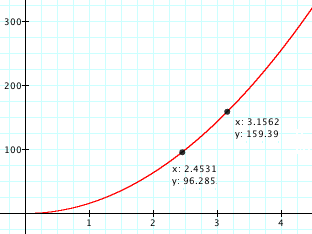
What was the object's average speed over the interval from 2.4531 seconds to 3.1562 seconds? It was the constant speed at a fictiious oject (FO) would need to fall to have traveled (159.39 - 96.285) feet in (3.1562 - 2.4531) seconds.
The question we wanted to answer, though, was how to produce a function who's graph tracks this FO's fall as if it began side-by-side with the actual object after the actual object had fallen for 2.4531 seconds.

which produces this graph
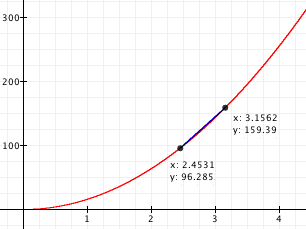
Was there anything special in the above about d(x)? No! We gave a general solution to a specific function with regard to the question of graphing the FO's trip from 2.4531 seconds to 3.1562 seconds. So, suppose we change the function that defines the actual object's distance from its start to d(t) = cos(7sin(t))? We get this graph.
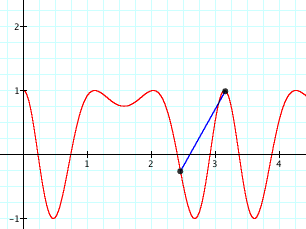
This graph is of the FO as it begins in the same location as the actual object at 2.531 seconds, ends in the same location as the actual object at 3.1562 seconds, and travels at a constant speed while moving.
Was there anything special about starting at 2.4531 seconds and ending at 3.1562 seconds? No. We started at some number of seconds (a) and traveled for some number of seconds (h). The actual object fell d(a) feet after having fallen for a seconds. It fell d(a+h) feet after having fallen for a+h seconds. So it fell at an average speed of ![]() feet/sec from a seconds to a+h seconds. Thus, the function definition that gives FO's distances at each moment of the actual objects fall over that interval is
feet/sec from a seconds to a+h seconds. Thus, the function definition that gives FO's distances at each moment of the actual objects fall over that interval is  .
.
Here is the graph of d [defined as d(t)=cos(7sin(t))] for a = 0.24 and h = 0.5644. The FO's graph shows that it started in the same location as the actual object, ended in the same location as the object after an additional 0.5644 seconds, and traveled at a constant speed while moving.
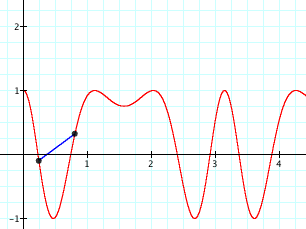
We began with a specific problem (graph the fall of an FO that falls at an actual object's average speed). We solved that problem by making reference to the function d, not to its actual definition. This allowed everything to still work even though we changed the function's definition. Then we noticed that the actual start and end times didn't matter, we simply needed to have a start time and a duration for the actual object's fall after that start time. We ended with a general function that produces a graph of an actual object's "average speed" function over the duration of the actual objec's fall.
Neat!